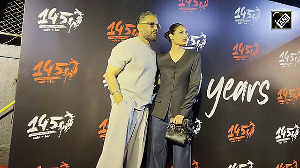Giving a new twist to the Ishrat Jahan case, Satish Verma, a member of the Special Investigation Team, claimed before the Gujarat High Court that the 2004 killings could have taken place in a fake encounter.
Verma, a senior IPS officer, who is part of the three-member probe team set up by the high court last year, also said that a second FIR with regard to the encounter needs to be filed. In an affidavit filed before a division bench of Justices Jayant Patel and Abhilasha Kumari, the IPS officer said, "The illustrative evidence brings out well founded allegation of a fake encounter. This is different from the version contained in the FIR". He enumerates various pieces of scientific evidence that go against the version in the FIR filed by the city crime branch after the encounter of Ishrat and three others -- Javed Ghulam Sheikh alias Pranesh Kumar Pillai, Amjad Ali alias Rajkumar Akbar Ali Rana and Jisan Johar Abdul Gani -- on June 15, 2004.
"The reply of the panel of doctors, who conducted the postmortem ... shows that the paths of many bullets inside the bodies of the deceased persons are not consistent with the FIR version of the incident," he said. The court appointed advocate Y S Lakhani as amicus curiae in the case and asked the SIT members to maintain discipline after differences among them came to fore.
Verma's affidavit states that bullet of the 9mm caliber weapon recovered from the body of Ali Rana, and twisted parts of 9mm caliber bullets recovered from Ishrat's body, do not match with any police weapon used during the encounter. The eight cartridge cases of 9mm caliber recovered from the car of the deceased persons do not match with the two 9mm caliber pistols recovered from the car itself, he says, adding that neither do the cases match with police weapon.
Verma said there were other infirmities in the police FIR. He said though the FIR mentions an intelligence input received by the city commissioner of police, there is no record of any such inputs. Also, there was no attempt to stop the vehicle in which the deceased were travelling by the officers at check-posts along the road, the affidavit said.
A police vehicle with an officer and his subordinate kept following Ishrat and her companion's vehicle for over 20 km. No alert was given to state police control, or the nearest city police station and no wireless message was sent. Also, the logbook entries of many of the police vehicles used during the encounter do not square with the time of the incident, he contended.
During the hearing, Verma told the high court that there are two possibilities in the case; one is that four people (who got) killed in the encounter had come to kill Gujarat Chief Minister (Narendra Modi), and the other is that they were killed in cold blood by the police". "There is a possibility of the second one (having taken place) irrespective of the first one," he told the court.
Verma also raised legal issues related to the investigation, saying no member of SIT can impose restrictions on investigation powers and duties of his colleagues. "There can be either controlled investigation or dynamic progressive investigation... the investigation cannot be controlled from Delhi...at every point you cannot get prior approvals, as it defeats the purpose of investigation," he said.
SIT head Karnail Singh told the court that "there is absence of chain of command and model code of conduct in the SIT. The power of SIT members needs to be defined. I am facing number of difficulties which cannot be discussed in the open court". After hearing both Verma and Singh, Court asked the SIT members to work as a team and maintain discipline.
The High Court also said that since the case was of national importance, the SIT should strive to unearth the truth. It further said that if there is difference of opinion, SIT members should get together and sort it out like 'responsible officers' before coming to the court. "If everybody files application for difference of opinion, how is the investigation going to proceed? Please act in a manner so that we achieve the objective of the SIT," the court said.
The division bench also made it clear that Singh was the chairman of the SIT and two other officers, Mohan Jha and Satish Verma were members, hence subordinate to him. "Decisions should be taken after discussion with all the members. If any member of SIT expresses dissenting views, it would be open for the SIT chief to proceed in accordance with law," the court said, adding that however, dissenting view should be noted. It also ordered the SIT to submit a progress report every two months.






